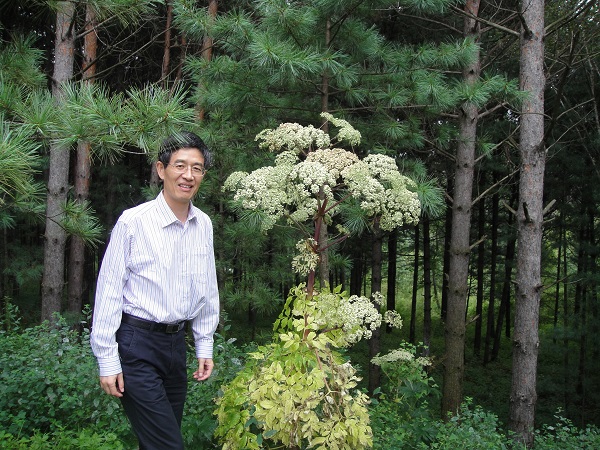|
杰出贡献奖名单
|
历届杰出贡献奖
 陈晓亚,生于1955年8月。植物生理学家,中国科学院院士、发展中国家科学院院士,中国科学院分子植物科学卓越创新中心/上海植物生理生态研究所研究员、博士生导师,长期从事植物学相关研究。1982年陈晓亚从南京大学生物学系毕业,1985年获得英国雷丁大学博士学位,1991年前往德国图宾根大学植物学系进行访问研究,1992年前往美国普渡大学从事博士后研究。1994年回国,进入中国科学院上海植物生理研究所工作;1999年获得国家杰出青年科学基金资助,2005年当选为中国科学院院士,2008年当选为发展中国家科学院院士。曾任植物分子遗传国家重点实验室主任(2002-2007年)、植物生理生态研究所所长(2002-2009年)、中国科学院上海生命科学研究院院长(2008-2013年)。现任中国植物生理与分子生物学学会理事长,上海辰山植物园园长、辰山植物科学研究中心主任,Plant Biotechnology Journal副主编等。获2008年何梁何利科学技术进步奖、2010年全国优秀博士学位论文指导教师奖、2015年上海科普杰出人物奖、2017年上海市自然科学奖一等奖等。 陈晓亚长期从事植物学相关研究,在植物资源、次生代谢、棉花生物学和植物抗虫新技术等方面做出了杰出成就,为植物学研究和上海辰山植物园的高质量发展做出了卓越贡献。主要科技成就体现在四个方面。 1. 植物资源收集及药用植物萜类化合物代谢调控研究 陈晓亚在攻读博士学位和在南京大学工作期间,开展了当归属和阿魏属的系统学研究,是我国最早将化学性状应用于植物分类学研究的学者之一。2005年起,受中国科学院委派,他参加了上海辰山植物园及中科院辰山植物科学研究中心的筹建、规划和发展。与此同时,他带领团队致力于唇形科药用植物资源的收集、保护和研究,收集唇形科植物三百余种,建成国内最大的鼠尾草属药用植物核心种质资源库以及保育繁殖基地。同时开展药用植物基因组学和代谢组学研究,解析了黄花蒿、广藿香、丹参、黄芩等药用植物次生代谢途径和调控机制;完成药用鼠尾草全基因组序列,揭示了丹参酮合成途径的演化与储藏根形成的关联;植物辅酶Q生物合成途径解析与代谢工程研究取得突破性进展。 2. 棉酚生物合成途径解析 锦葵科棉属植物通过合成棉酚等倍半萜化合物来抵御病菌侵染和虫鼠取食,但棉籽中高含量的棉酚限制其作为油料和饲料原料的广泛应用。陈晓亚团队系统研究棉酚生物合成30余年,先后克隆鉴定了提供倍半萜前体的法尼基二磷酸合酶FPS,形成棉酚基本骨架的杜松烯合酶CDN,修饰骨架形成功能基团的细胞色素P450单加氧酶(CYP706B1、CYP82D113、CYP71BE79、CYP736A196)和双加氧酶2-ODD-1、醇脱氢酶DH1、芳香化酶SPG,以及控制左旋和右旋棉酚对映异构体形成的引导蛋白GhDIR5和GhDIR6,从而完整解析了棉酚生物合成途径。在基因组水平上解释锦葵科棉属植物棉酚生物合成途径演化的基础,并创制了种子低酚和去除左旋棉酚的新种质,提高了棉籽利用价值。棉酚生物合成途径的完整解析是植物次生代谢研究领域的重要进展,对棉花品质改良具有重要意义。 3. 阐明棉纤维发育分子机制 在棉纤维发育分子机制研究中,陈晓亚团队鉴定了棉纤维细胞壁延展蛋白RDL1,发现棉花HD-ZIP类转录因子HOX3是控制棉纤维伸长的关键因子,发现受miR319调控的TCP4通过与HOX3互作协调棉纤维伸长和次生壁加厚,细胞伸长促进因子PRE1的D亚组基因启动子区的突变对棉纤维品质性状形成具有重要意义。此外,他还参与了陆地棉和海岛棉基因组测序,为棉属植物研究做出了贡献。 4. 研发RNAi抗虫新技术 次生代谢物在植物-昆虫互作与共进化过程中发挥重要作用。通过研究棉铃虫对棉酚的解毒机制,陈晓亚团队研发了植物介导的RNAi抗虫技术,能够通过在植物中表达特异的双链RNA来干扰昆虫基因表达并抑制其生长。这一成果是植物抗虫技术发展的里程碑式突破,被国内外多家机构用来研发新型抗病虫作物。此外,他的团队还提出了次生代谢产物诱导昆虫抗药性发展的新观点,阐述了植物生长过程中防御激素信号的动态特征。特别值得一提的是,他们还通过基因工程使植物的根分泌漆酶来转化土壤中的酚类污染物,从而为环境修复提供了新策略。 迄今为止,陈晓亚在国内外学术期刊发表论文约200篇,包括Nature Biotechnology、Nature Chemical Biology、Nature Plants、PNAS、Plant Cell、Molecular Plant等重要刊物,SCI引用超过1.3万次,多次入选科睿唯安年度高被引研究者,获国内外授权发明专利30余项。已培养博士后、博士和硕士80 余名,其中有10 余名学术带头人活跃在植物学相关研究领域。他还主编或参与主编的《植物生理与分子生物学》(中国科学院研究生院教材)、《十万个为什么—植物》(第六版)等著作,为我国植物科学发展、研究生培养和科普教育做出了重要贡献。 Professor Xiao-Ya Chen, Principal investigator of CAS Center for Excellence in Molecular Plant Sciences/Institute of Plant Physiology and Ecology (CEMPS), Chinese Academy of Sciences, and the Director of Shanghai Chenshan Botanical Garden. He graduated from Prof. Chen has been engaged in plant science research for a long time, and has made outstanding achievements in plant resources, secondary metabolism, cotton biology, and innovation of plant biotechnology against insect pests. He has made outstanding contributions to botany research and the development of Shanghai Chenshan Botanical Garden. The main achievements are reflected in four aspects. 1. Collection of medicinal plants and investigation of terpenoid biosynthesis During his doctoral studies and work at Nanjing University, Xiao-Ya Chen conducted systematic research on plants of Angelica and Ferula, family Umbelliferae, and was one of the earliest scholars in China to do plant chemotaxonomy research. Since 2005, appointed by the Chinese Academy of Sciences, he joined the team of designing, planning and construction of Shanghai Chenshan Botanical Garden. He has made important contributions to the establishment of Chenshan Plant Science Research Center of the Chinese Academy of Sciences, and the development of science research programs. At the same time, he led a team dedicated to the collection, conservation, and research of medicinal plant resources in the Labiatae family, collecting over 300 species of Labiatae plants, and building the largest core germplasm resource bank, as well as the conservation and breeding nursery of Salvia plants from China and abroad. They have made important progresses in genomics and metabolomics research of medicinal plants, such as Salvia miltiorrhiza, S. officinalis, Artemisia annua, patchouli and Scutellaria baicalensis. Their researches have revealed correlation between the evolution of tanshinone synthesis pathway and the formation of storage roots. Breakthrough progress has been made in the elucidation and metabolic engineering of plant coenzyme Q biosynthetic pathway. 2. Elucidation of gossypol biosynthetic pathway Cotton plants in the genus Gossypium of Malvaceae family synthesize sesquiterpenoid compounds, such as gossypol, to resist pathogen infection and insect feeding. The high content of gossypol in cotton seeds, however, limits their application as vegetable oil and feeding stuff. Prof. Chen's group has devoted to the studies of gossypol biosynthesis for more than 30 years, and has fully elucidated the biosynthetic pathway of from farnesyl diphosphate (FDP) to gossypol. They cloned and identified the FDP synthase (FPS) that provides sesquiterpene precursors, the (+)-delta-cadinene synthase (CDN) that forms the basic backbone of gossypol, the cytochrome P450 monooxygenase (CYP706B1, CYP82D113, CYP71BE79, CYP736A196), the dioxygenase 2-ODD-1, the alcohol dehydrogenase DH1, and the aromatase SPG that modify and decorate the skeleton to form functional groups, and finally the dirigent proteins GhDIR5 and GhDIR6 that impart the hemigossypol oxidative coupling into (−)- and (+)-gossypol, respectively. To reduce cotton seed toxicity, they disrupted GhDIR5 gene by genome editing, resulting in effective elimination of (−)-gossypol from cottonseed without affecting other phytoalexins, including (+)-gossypol, that provide pest resistance, thereby improving the utilization of cottonseed products. The elucidation of gossypol biosynthetic pathway is an important progress in the field of plant secondary metabolism research, and of great importance in improving cotton quality. 3. Dissect the regulatory mechanism of cotton fiber elongation In the research of cotton fiber development, Chen's group identified that the cotton HD-ZIP transcription factor HOX3 is a master regulator of cotton fiber elongation. HOX3 interacts with DELLA protein to transduce the gibberellin signal into fiber cell growth, and with the miR319-targeted TCP4 to coordinate cotton fiber elongation and secondary wall thickening. They also characterized genes involved in cotton fiber cell elongation (PRE1) and cell wall loosening (RDL1). All these findings are of great importance for the formation of cotton fiber quality traits. In addition, they were also involved in sequencing of upland cotton and island cotton genomes. 4. Develop RNAi technology for plant protection Secondary metabolites play an important role in plant-insect interactions and coevolution. During analyzing the detoxification mechanism of cotton bollworm towards gossypol, they developed the plant-mediated insect RNAi by expressing double stranded RNA of insect gene in plants, so that the growth of insect feeders are inhibited. This achievement is a milestone breakthrough in the development advanced biotechnology for plant protection against pests and pathogens, and has been widely used in many institutions to develop crops with enhanced disease or pest resistance. In addition, their research revealed the “double-edged sword” role of plant secondary metabolites in plant-insect interactions, and the dynamic changes of plant immunity or defense reactions during plant aging. Besides, they also engineered plant to secrete laccase from root to transform phenolic pollutants in the soil, thus providing new strategies for soil remediation. Prof. Chen has published about 200 papers in scientific journals, including Nature Biotechnology, Nature Chemical Biology, Nature Plants, PNAS, Plant Cell, Molecular Plant, and has been listed as Highly Cited Researcher by Clarivate multiple times. He has more than 30 authorized invention patents. To date more than 80 postdocs, PhD and Master Degree graduate students have worked or studies in his laboratory. He has edited or jointly edited books, including “Plant Physiology and Molecular Biology” (a textbook for graduate schools), “On Hundred Thousand Whys - Plants (sixth edition)”. He has contributed to plant science research, education, popularization, and plant conservation in China. |
版权所有 Copyright © 2015-2019 云南吴征镒科学基金会,All Rights Reserved 【滇ICP备05000394号】
地址:中国云南省昆明市蓝黑路132号 邮政编码:650201
点击这里联系我们
